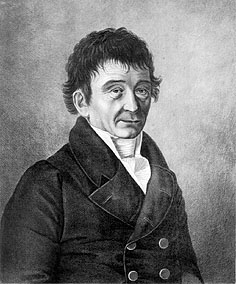<Back to Index>
- Physicist Ernst Florens Friedrich Chladni, 1756
- Writer Christian Matthias Theodor Mommsen, 1817
- King of Poland Casimir IV Jagiellon, 1427
PAGE SPONSOR

Ernst Florens Friedrich Chladni (November 30, 1756 – April 3, 1827) was a German physicist and musician. His important works include research on vibrating plates and the calculation of the speed of sound for different gases. For this some call him the "Father of Acoustics". He also did pioneering work in the study of meteorites, and therefore is regarded by some as the "Father of Meteoritics" as well.
Although Chladni was born in Wittenberg, Germany, Chladni's family was from Kremnica, a mining town now in central Slovakia, then part of the Kingdom of Hungary. This has led to Chladni as being identified in the literature as German, Hungarian and Slovak.
Chladni came from an educated family of academics and learned men. Chladni's great - grandfather, Georg Chladni (1637 – 92), a Lutheran clergyman, had to flee Kremnica on October 19, 1673 during the Counter Reformation. Chaldni's grandfather, Martin Chladni (1669 – 1725), was also a Lutheran theologian, and in 1710 became professor of theology at the University of Wittenberg, and from 1720 - 1721 was dean of the faculty of theology and later rector of the university. Chaldni's uncle, Justus Georg Chladni (1701 – 1765), was a law professor at University of Wittenberg.
Another uncle, Johann Martin Chladni (1710 – 1759), was a theologian and historian, and professor at the University of Erlangen and the University of Leipzig. Chladni's father, Ernst Martin Chladni (1715 – 1782), was a law professor and rector of the University of Wittenberg, where he joined the law faculty in 1746. Chaldni's father disapproved of his son's interest in science and insisted that Chladni become a lawyer.
Chladni studied law and philosophy in Wittenberg and Leipzig, and obtained a law degree in 1782 from the University of Leipzig. When his father died in 1782, Chladni began his research in physics in earnest.
Chladni died in 1827 in Breslau, Lower Silesia, an area that is now in southwestern Poland. When Chladni died, this town was part of the Kingdom of Prussia, which was a member of the German Confederation. One of Chladni's best known achievements was inventing a technique to show the various modes of vibration on a mechanical surface. Chladni repeated the pioneering experiments of Robert Hooke of Oxford University who, on July 8, 1680, had observed the nodal patterns associated with the vibrations of glass plates. Hooke ran a bow along the edge of a plate covered with flour, and saw the nodal patterns emerge. Chladni's technique, first published in 1787 in his book, Entdeckungen über die Theorie des Klanges ("Discoveries
in the Theory of Sound"), consisted of drawing a bow over a piece of
metal whose surface was lightly covered with sand. The plate was bowed
until it reached resonance and the sand formed a pattern showing the
nodal regions. Since the 20th century it has become more common to
place a loudspeaker driven by an electronic signal generator over
or under the plate to achieve a more accurate adjustable frequency.
Variations of this technique are commonly used in the design and
construction of acoustic instruments such as violins, guitars, and cellos. Since
at least 1738, a musical instrument called a "Glassspiel" or "Verillon"
created by filling 18 beer glasses with varying amounts of water was
popular in Europe. The beer glasses would be struck by wooden mallets shaped like spoons to produce "church and other solemn music". Benjamin Franklin was sufficiently impressed by a verillon performance on a visit to London in 1757 that he created his own instrument, the "armonica" in 1762. Franklin's
armonica inspired several other instruments, including two created by
Chladni. In 1791, Chladni invented the musical instrument called "Chladni's Euphonium" (not to be confused with the brass instrument euphonium),
consisting of glass rods of different pitches. Chladni's euphonium is
the direct ancestor of the modern day musical instrument known as the Cristal Baschet. Chladni also improved on the Hooke "musical cylinder" to produce another instrument, the "Clavicylinder", in 1799. Chladni travelled throughout Europe with his instruments giving demonstrations.
Chladni discovered
Chladni's law, a simple algebraic relation for approximating the modal frequencies of the free oscillations of plates and other bodies. Chladni
estimated sound velocities in different gases by placing those gases in
an organ pipe, playing it, and observing the sounds that emerged. This built on the work of Pierre Gassendi in measuring the speed of sound in air, begun in 1635. In 1794, Chladni published, in German, Über
den Ursprung der von Pallas gefundenen und anderer ihr ähnlicher
Eisenmassen und über einige damit in Verbindung stehende
Naturerscheinungen, (On the Origin of the Pallas Iron and Others Similar to it, and on Some Associated Natural Phenomena), in which he proposed that meteorites have their origins in outer space. This was a very controversial statement at the time, since
meteorites were thought to be of volcanic origin. With this book
Chladni also became one of the founders of modern meteorite research.
Chladni was ridiculed at first for this claim, but it was confirmed in
1803 by Jean Baptiste Biot.